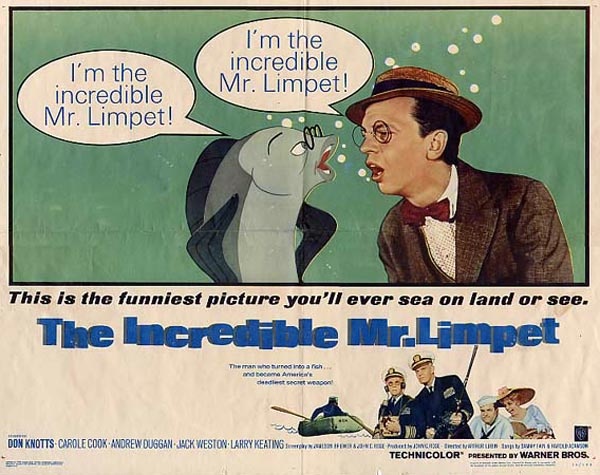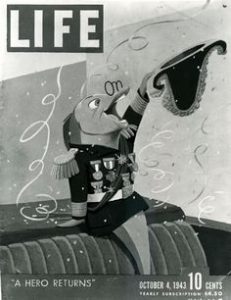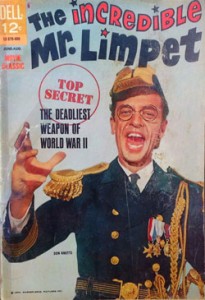



“Mr. Limpet is sure to be the most incredibly delightful movie about a man who turns into a fish that you’ll see this year!”
This tagline from the original trailer of 1964’s The Incredible Mr. Limpet may rank as one of the safest marketing campaigns. However, the film, which celebrates its 60th anniversary this year, has become a likable favorite for many and has developed quite a following.
 Combining live-action and animation, The Incredible Mr. Limpet (based on the book by Theodore Pratt) is told in flashback to the 1940s. It tells the story of the title character, a meek bookkeeper from Brooklyn named Henry Limpet, who is classified as 4F due to poor eyesight and is frustrated at being unable to enlist in the Navy.
Combining live-action and animation, The Incredible Mr. Limpet (based on the book by Theodore Pratt) is told in flashback to the 1940s. It tells the story of the title character, a meek bookkeeper from Brooklyn named Henry Limpet, who is classified as 4F due to poor eyesight and is frustrated at being unable to enlist in the Navy.
Henry loves fish, keeping many as pets in his large aquarium and studying all about them. This is to the chagrin of both his wife, Bessie, who doesn’t treat Henry very well, and his somewhat fair-weather friend, George, a machinist in the Navy, who teases Henry that he hasn’t been able to enlist.
When the three take a trip to Coney Island, Henry falls into the water while reading a book on the theory of reverse evolution and is transformed into a fish (which is where The Incredible Mr. Limpet transitions to animation to bring Henry’s fish persona and the other sea life to the screen).
Underwater as a fish, Henry hears a radio on land reporting the events of December 7, 1941, and decides that now that he is no longer classified as 4F, he can help the war effort.
 In his fish form, Mr. Limpet partners with his buddy George and is able to assist the U.S. Navy. Henry discovers that he is capable of making a loud “thrum,” sonar-like noise, and he winds up supporting the Navy as a “secret weapon” to help defeat the Nazis.
In his fish form, Mr. Limpet partners with his buddy George and is able to assist the U.S. Navy. Henry discovers that he is capable of making a loud “thrum,” sonar-like noise, and he winds up supporting the Navy as a “secret weapon” to help defeat the Nazis.
The live-action sections of The Incredible Mr. Limpet were directed by Arthur Lubin, whose credits included Universal Studios’ 1943 version of The Phantom of the Opera, as well as the Abbott and Costello comedies Buck Privates and Hold That Ghost (both 1941).
The animated segments were helmed by the legendary Vladimir “Bill” Tytla, who, while an animator at Disney, had brought such dynamic, memorable characters to the screen as Chernabog in Fantasia and Stromboli in Pinocchio (both 1940).
However, in his book Hollywood Cartoons: American Animation in its Golden Age, writer, and historian Michael Barrier noted that Tytla wasn’t responsible for directing all of the animation in the film: “Bill Tytla, by then in the later stages of a long professional and physical decline, worked briefly on Limpet in 1962 and received screen credit as its animation director (Jack Kinney was the first choice of the film’s producer, John Rose, but Kinney and Rose could not agree on terms.)”
Two other industry legends were also brought in to direct the animation, as contributor Andrew Leal wrote in Jerry Beck’s book The Animated Movie Guide: “Robert McKimson and Hawley Pratt had to take over much of the work on the film.”
 The film’s ending credits also list Gerry Chiniquy as an associate director.
The film’s ending credits also list Gerry Chiniquy as an associate director.
Sadly, The Incredible Mr. Limpet also marked the end of an era at Warner Bros, the studio behind the film. The film was the final project for the studio’s heralded animation department, and it closed temporarily after production (in 1964, DePatie-Freleng Enterprises leased the Warner Bros. Cartoon Studio and were contracted to produce Looney Tunes and Merrie Melodies cartoons).
Despite such tumultuous events during production, the animation in The Incredible Mr. Limpet (referenced in the credits as “Special Piscatorial Effects”) is very well done.
Henry’s transition to fish is dynamic, with a morphing silhouette sequence. Additionally, the backgrounds, credited to Don Peters, are also crafted nicely, and the live-action/animation combination of Mr. Limpet, when he pops his head out of the water, is very effective.
Also, the film’s action-sequence finale, where Henry attempts to outrun and deflect torpedoes, is staged effectively, switching between live-action and animation.
 The film’s character designs are also well fashioned, particularly Mr. Limpet, who is a caricature of the film’s star, Don Knotts. The Incredible Mr. Limpet was made at the height of Knotts’ popularity on The Andy Griffith Show, and he played both the live-action Mr. Limpet and provided the voice of his animated fish counterpart very effectively.
The film’s character designs are also well fashioned, particularly Mr. Limpet, who is a caricature of the film’s star, Don Knotts. The Incredible Mr. Limpet was made at the height of Knotts’ popularity on The Andy Griffith Show, and he played both the live-action Mr. Limpet and provided the voice of his animated fish counterpart very effectively.
The film’s cast also included Jack Weston as George, Carole Cook as Bessie, Andrew Duggan as Captain Harlock, Larry Keating as Admiral Spewter, and the voices of Elizabeth McRae as Henry’s underwater love interest, Ladyfish, and ubiquitous voice acting legend Paul Frees as the voice of Crusty the crab.
The Incredible Mr. Limpet also featured entertaining songs by Sammy Fain (music) and Harold Adamson (lyrics). They included “I Wish I Were a Fish,” which singer Arthur Godfrey (who appeared in the trailer promoting the film) recorded as a single. For more on the music of Mr. Limpet, check out Greg Ehrbar’s 2017 article.
The Incredible Mr. Limpet had its premiere at the Weeki Wachee Springs Underwater Theater in Florida on January 20, 1964, and was released to theaters everywhere on March 28th. The film received mixed reviews, although many had favorable words for the film’s animation and effects, such as The Hollywood Reporter’s film critic, who wrote:
“The animation sequences directed by Vladimir Tytla maintain the same spirit as the live-action sequences. A triumph is the animator’s art in approximating Knott’s distinctive features. The blend of live-action and animation is good.”
In the six decades since its debut, many have become fans of The Incredible Mr. Limpet, including actors and filmmakers who have toyed with the idea of a remake. Jim Carrey came the closest in the late ‘90s when animation tests involving motion capture were done of Carrey as a fish.
After that re-make didn’t pan out, everyone from Mike Judge and Robin Williams to Zach Galifianakis and Richard Linklater were involved in remakes that never materialized.
This continued interest in The Incredible Mr. Limpet sixty years later proves that the film’s original trailer was correct, and it continues to be the “most incredibly delightful movie about a man who turns into a fish!”